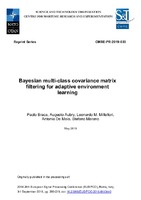| dc.contributor.author | Braca, Paolo | |
| dc.contributor.author | Aubry, Augusto | |
| dc.contributor.author | Millefiori, Leonardo | |
| dc.contributor.author | De Maio, Antonio | |
| dc.contributor.author | Marano, Stefano | |
| dc.date.accessioned | 2019-06-18T12:15:17Z | |
| dc.date.available | 2019-06-18T12:15:17Z | |
| dc.date.issued | 2019/05 | |
| dc.identifier.govdoc | CMRE-PR-2019-033 | en_US |
| dc.identifier.uri | http://hdl.handle.net/20.500.12489/774 | |
| dc.description.abstract | Covariance matrix estimation is a crucial task in adaptive signal processing applied to several surveillance systems, including radar and sonar. In this paper we propose a dynamic environment learning strategy to track both the covariance matrix and its class; the class represents a set of structured covariance matrices. We assume that the posterior distribution of the covariance given the class, is basically a mixture of inverse Wishart, while the class posterior distribution evolves according to a Markov chain. The proposed multi-class inverse Wishart mixture filter is shown to outperform the class-clairvoyant maximum likelihood estimator in terms of covariance estimate accuracy, as well as the Bayesian information criterion rule in terms of classification performance. | en_US |
| dc.format | 5 p. : ill. ; digital, PDF file | |
| dc.language.iso | en | en_US |
| dc.publisher | CMRE | en_US |
| dc.source | In: 2018 26th European Signal Processing Conference (EUSIPCO), Rome, Italy, 3-7 September 2018, pp. 266-270, doi: 10.23919/EUSIPCO.2018.8553440 | en_US |
| dc.subject | Adaptive signal processing | en_US |
| dc.subject | Signal processing | en_US |
| dc.subject | Covariance | en_US |
| dc.subject | Bayesian statistical decision theory | en_US |
| dc.subject | Adaptive filters | en_US |
| dc.title | Bayesian multi-class covariance matrix filtering for adaptive environment learning | en_US |
| dc.type | Reprint (PR) | en_US |
| dc.type | Papers and Articles | en_US |
